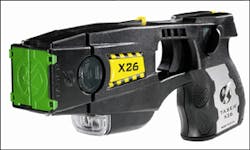Please Tase Me Bro!
A recent article in USA Today written by Kevin Johnson was posted on Officer.com in April. The article, Better Defense Tactics Helping to Curb Law Enforcement Deaths, was premised on the fact that since there has been more of an emphasis on defensive tactics training, police deaths have been cut in half this year when compared to the spike in line of duty (LOD) deaths in 2007. Thankfully, LOD deaths have decreased so far this year, but my sense is that better DT training is only a small part of the answer.
Defensive tactics has been around for years in one form or another. One of the problems that police departments have had is the reactive stance that we assume in most of our training. Until some tragedy occurs that causes us to reassess our training, we continue to utilize the same tactics year in and year out. The big reason for that, more often than not, is money. Whenever a trainer learns of a new way to do something more effectively, safer, or quicker, the first question the admin folks ask is, "How much will this cost to train our department?"
One big exception to that general rule is ground fighting. In the last several years, most departments have included this skill set in their DT curriculum. For the longest time we used to put boxing gloves on trainees and let them knock the snot out of each other. For all the time and money spent on that pursuit, the rewards never materialized. The only thing of value realized from that exercise was that some trainees that had never been hit before finally had an idea of what to expect on the street. Ground fighting is much more of a practical skill to teach. Ask any DT Instructor or working street cop, and they will tell you that after a punch or two is thrown, everything is going to the ground. Thanks Royce Gracie.
Technology has enabled us to grow the number of options that we can reach for when confronted by the bad guys. Before chemical agents debuted, we either used our night sticks (now called batons) or went toe to toe with non compliant folks. Fisticuffs are definitely the "manly" way of compelling a person to cooperate. Unfortunately many of us couldn't punch our way out of a paper bag. We either wound up getting our clocks cleaned, had a heart attack from the shock and exertion involved, or put ourselves in danger of having our weapon taken away.
Mace and OC allowed us to take a somewhat safer approach by standing back and spraying. Of course the downside was that not everyone was affected by the spray, except for the officer and his partners, so you could never guarantee that it would be effective. Additionally, some officers have an expectation that the spray will incapacitate someone - it doesn't; it gives us the opportunity to jump into the gap created to regain control. However, it is still a good idea to have another less lethal option available.
Enter the Taser®; probably the most effective and safest less lethal weapon to emerge on the law enforcement scene in years. In my opinion, the Taser is the reason why LOD deaths have decreased. The Taser's® effectiveness has resulted in fewer hand to hand combat incidents. The more often that we can deal with non compliant subjects at an arm's length, the safer we remain. Inasmuch as Taser® has now become a household word, especially since the infamous words, "Don't tase me, bro," were spoken by the imbecile at the University of Florida in September of 2007, the Taser® has developed a reputation on the street that makes it a formidable weapon. Incidentally, for those that don't know, the student involved in that Taser® incident eventually admitted that his actions were out of line. He apologized and conceded that the officers did nothing wrong. All his charges will be dismissed if he completes an 18 month probation period.
Given the Taser's® effectiveness on non compliant subjects, and the fact that it has saved many of our officers from having to go hands on with cretins that won't take no for an answer, why is it that some jurisdictions refuse to supply this great tool to the guys and gals on their department? Fewer physical confrontations means fewer job related injuries and thus fewer workman's comp claims. According to Taser's® website, police departments have experienced anywhere from 25-80% reduction in officer injuries upon deployment of the tool. Hey folks, we're not getting paid to get hurt by knuckle draggers. DT training is fine, and must continue to be emphasized, but Tasers are a great option to have on the tool belt. They are the technology that helps keep cops on the road, not in the emergency rooms.
New York, New Jersey, Rhode Island, and all the other states that have not approved the use of Tasers® by their officers, in my opinion, are being ethically disingenuous. From either the perspective of the officers themselves, or the citizenry that will be on the receiving end of this technology, it is morally incorrect not to include this in the use of force continuum. If I am facing someone larger than myself who refuses to obey my commands, more often that not I will choose the Taser® to gain compliance. I dare say that most officers would opt to do so as well, over hand to hand, OC, or baton. Why are LOD deaths down this year compared to 2007? The Taser®!
Stay safe brothers and sisters!
